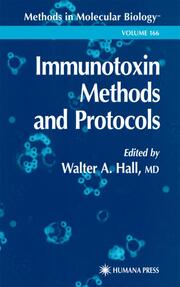Detailansicht
Immunotoxin Methods and Protocols
Methods in Molecular Biology 166
ISBN/EAN: 9780896037755
Umbreit-Nr.: 1425519
Sprache:
Englisch
Umfang: xi, 297 S.
Format in cm:
Einband:
gebundenes Buch
Erschienen am 22.12.2000
- Zusatztext
- Immunotoxins represent a new class of human therapeutics that have widespread applications and a potential that has not yet been fully recognized since they were first conceived of by Paul Ehrlich in 1906. The majority of advances in the development and implementation of immunotoxins has occurred over the last 20 years. The reasons for this use of immunotoxins in basic science and clinical research are the powerful concurrent advances in genetic engineering and receptor physiology. Recombinant technology has allowed investigators to produce sufficient quantities of a homogeneous c- pound that allows clinical trials to be performed. The identification of specific receptors on malignant cell types has enabled scientists to generate immunotoxins that have had positive results in clinical trials. As more cellular targets are identified in coming years, additional trials will be conducted in different disease states affecting still larger patient populations. Modulation of the immune system to decrease the humoral response to immunotoxins may improve their overall efficacy. As increasingly more effective compounds are generated, it will be necessary to decrease the local and systemic toxicity - sociated with these agents, and methods for doing so are presently being - veloped. The work presented in Immunotoxin Methods and Protocols focuses on three specific areas of immunotoxin investigation that are being conducted by experts throughout the world. The first section describes the construction and development of a variety of immunotoxins.
- Kurztext
- More potent and selective for killing cancer cells than chemotherapy, immunotoxins constitute a new class of human therapeutics that have widespread applications and a potential that has not yet been fully recognized. In Immunotoxin Methods and Protocols, leading experts from laboratories around the world describe in step-by-step detail their cutting-edge methods for developing and applying these powerful proteins. The conjugates created by these researchers contain entire monoclonal antibodies, single chain antibody fragments, and cytokines as their carrier ligands. Their toxic portion can include such conventional chemotherapeutics as doxirubicin, such ribosome-inactivating proteins as the ricin A chain or saporin, or such bacterial toxins as diptheria toxin. Also described are a variety of applications that demonstrate the versatility of these agents, including the treatment of primary malignant brain tumors, the generation of selective brain lesions to localize critical functions, and the targeting of the AIDS virus. Each readily reproducible method is optimized for experimental success with hands-on instructions, invaluable notes on pitfalls to avoid, and informative explanations of why certain steps are necessary. Authoritative and highly practical, Immunotoxin Methods and Protocols provides today's cancer researchers, neuroscientists, and oncologists with state-of-the-art tools for exploring these powerful biological agents and their rapidly increasing applications.
- Autorenportrait
- InhaltsangabePart I. Immunotoxin Construction and Development. Development and Activities of the BR96-Doxorubicin Immunoconjugate, Ingegerd Hellström, Karl Erik Hellström, and Peter D. Senter. CD7-Specific Single Chain Fv Immunotoxins: Design and Expression, Christopher A. Pennell and Mary E. Pauza. Recombinant Fusion Toxins Directed Against the Human Granulocyte-Macrophage Colony Stimulating Factor (GM-CSF) Receptor, Yu Shao, Berta E. Warman, and John P. Perentesis. Synthesis of Monensin Derivatives and Their Effect on the Activity of Ricin A-Chain Immunotoxins, Marco Colombatti and Franco Dosio. Purification and Conjugation of Type 1 Ribosome-Inactivating Proteins, Luigi Barbieri, Andrea Bolognesi, and Fiorenzo Stirpe. Comparison of Immunotoxins Bearing a Single Saporin Molecule with Multiple Toxin Conjugates, David J. Flavell and Sopsamorn U. Flavell. Modulation of Growth Factor Receptor Expression by Irradiation for Immunotoxin Targeting, Ki-Uk Kim, Hsaio-Tzu Ni, Stephen R. Spellman, Kwan H. Cho, Walter C. Low, and Walter A. Hall. Quantification of Immunotoxin Number for Complete Therapeutic Response, Robert J. Kreitman. In Vitro Studies of Ricin A-Chain-Induced Vascular Leak Syndrome, Alan L. Lindstrom and Christopher A. Pennell. Part II. Oncologic Applications of Immunotoxins. Immunotoxin Treatment of Brain Tumors, Walter A. Hall. Cytotoxins Directed at Interleukin-4 Receptors as Therapy for Human Brain Tumors, Raj K. Puri. Bispecific Monoclonal Antibodies for the Targeting of Type I Ribosome-Inactivating Proteins Against Hematological Malignancies, Silvano Ferrini, Sabrina Sforzini, and Silvana Canevari. Tyrosine Kinase Inhibitors Against EGF Receptor-Positive Malignancies, Elise A. Sudbeck, Sutapa Ghosh, Xing-Ping Liu, Yaguo Zheng, Dorothea E. Myers, and Fatih M. Uckun. Targeting Tumor Vasculature Using VEGF-Toxin Conjugates, S. Ramakrishnan, Robert Wild, and Dana Nojima. Gene Therapy with Immunotoxins, Daniel A. Vallera. Part III. Alternative Applications ofImmunotoxins. Effects of Selective Immunotoxic Lesions on Learning and Memory, Mark G. Baxter. Targeting Toxins to Neural Antigens and Receptors, Ronald G. Wiley. In Vivo Testing of Anti-HIV Immunotoxins, Seth H. Pincus, Tamera K. Marcotte, Brent M. Forsyth, and Hua Fang. Index.
